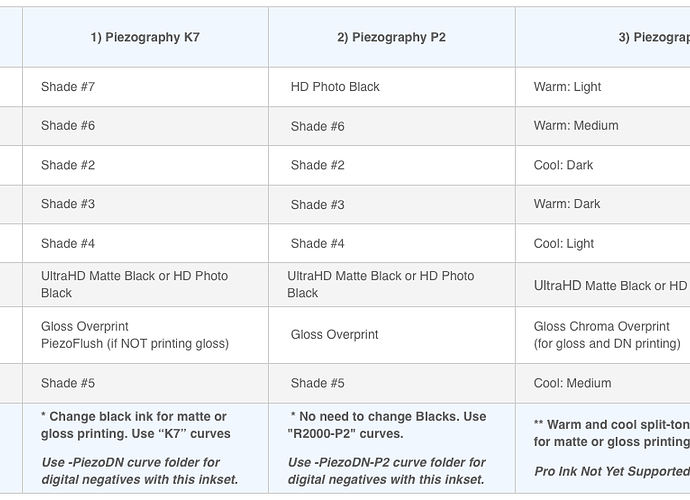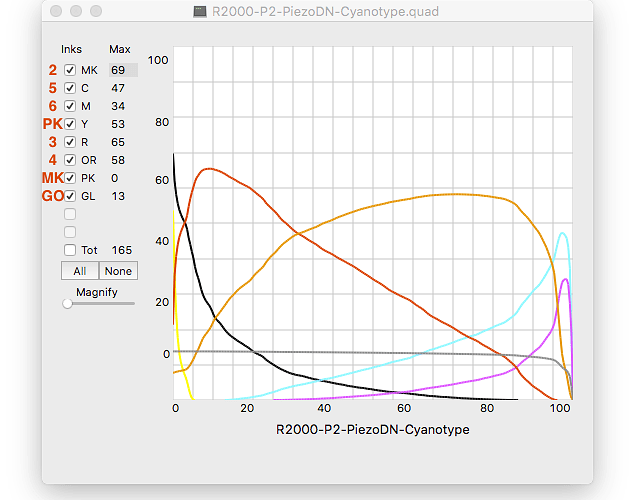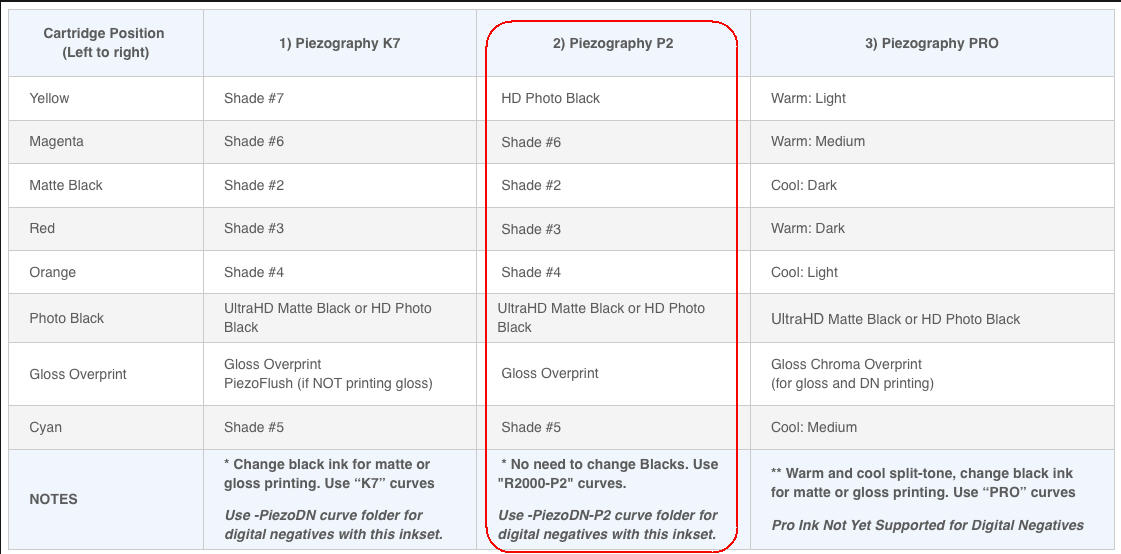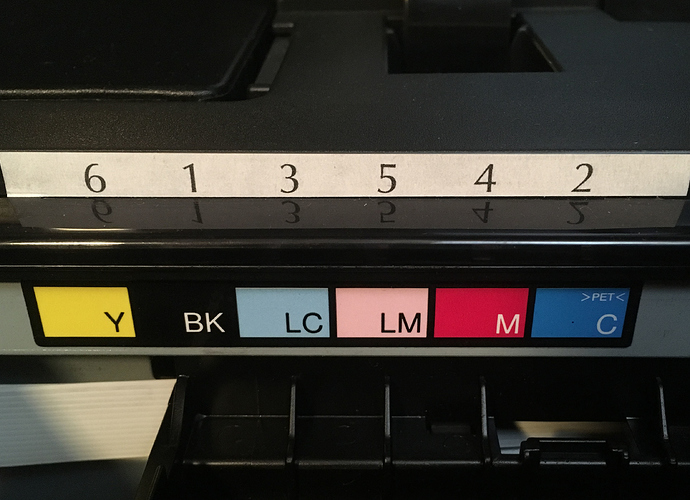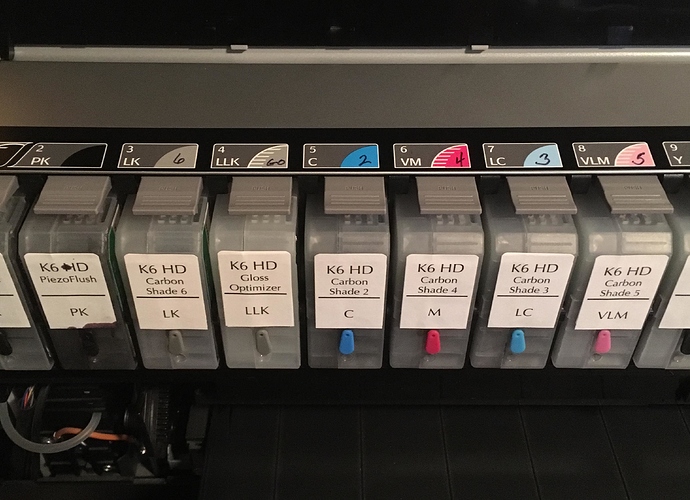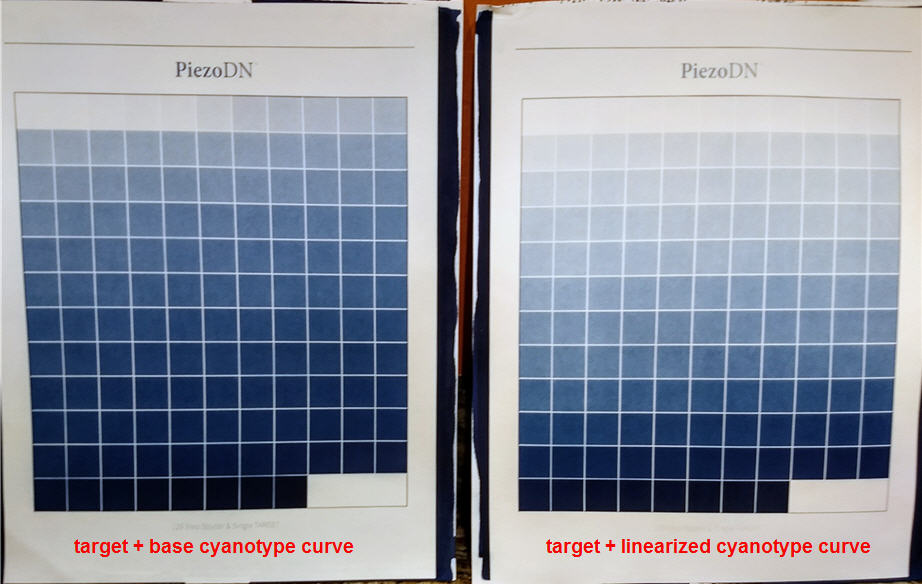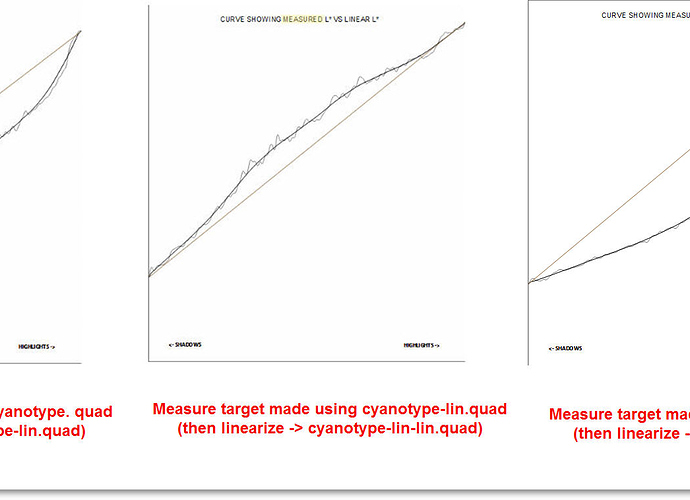Keith, I tried coating with GO and in my 14-20% humidity studio it actually flaked off in places. My negs are pretty resilient but I do let them air dry in a drawer overnight. In the morning I can no longer rub off the Matte Black which I have set to print for paperwhite only. Part of my solution to the long conversation we had before.
I would add for John, try backing off exposure 10% and just see what happens. It would be worth coating a number of sheets (potassium ferricyanide is cheap). and questioning everything you know. One negative will do it all and give you a control for your experimenting.
You are correct, something seems wrong and with everyone teleporting to try and solve it no one is actually looking over your shoulder to spot that one thing you don’t even know to mention.
John - Sorry if I contributed to the confusion about the starting curve. I did name one of my CurveView screenshots Cyan-Master, but it referred to the IJM supplied Cyanotype curve, not to the Master curve.
I too always run a nozzle check before each negative, and I did so before and after the one I mentioned where the K channel didn’t print at all. Both were perfect. I still have no idea what happened in those cases and am just grateful it has happened only 2 or 3 times.
Back to the question about ink positions. You are using the P2 setup on your P400, but I can’t find a document that shows what that is. The document titled Insert #106, which is what is linked to from the P400 ink page on the store website, and which probably came with your inks and cartridges too, is where I got the chart that I posted. It does not show P2 ink positions for the P400/R2000. I did find this chart in a document on the Piezography Support Knowledge Base page:
[attachment file=30207]
I’m guessing this must be what you used. Is this correct?
Here is an annotated CurveView of the Cyanotype (Master) curve correlating ink position to ink shade:
[attachment file=30208]
I got the positions from the bottom table on p. 3 of Insert# 106 (see attachment). I pointed out to Walker that the table is missing a heading. The heading should list the P400 (see attachment). The tables are confusing.
Here’s a shot of the carts, as installed, from an earlier post (attachment 2 - ignore the red arrow).
The IJM carts are keyed to the colors on the Epson printer (attachment 3), so you only have to match them up. It would be hard to make a mistake.
Thank you and Walker both for clarifying “Master”.
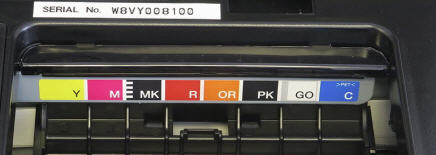
That’s wacky! The first ink placement chart that I posted was downloaded from the link on the P400 reusable cart page. It has the UC3 ink positions rather than whatever the P400 inks are called. That’s why I was confused. It’s not the same as what you posted, which is the same as the second one I posted. Anyhow, it looks like you are set up correctly. FWIW, I make another set of labels that I put on either the carts or the printer itself (like your 3rd pic), or both, with the actual Piezo inks that go in the carts. It has kept me from making stupid mistakes more than once.
[attachment file=30216]
[attachment file=30217]
Earlier I couldn’t post, now I get a double post. Sorry - there doesn’t seem to be a delete button.
Today I began another linearization, starting from the very beginning. This time I will carefully control my darkroom variables: allow negatives to cure for 24h, allow prints to sit fo 24h before measuring with spectro, and so-on. I’ll post again when I have results. Thanks again Keith and Walker for your help and encouragement.
Today I’m repeating the linearization of the cyanotype base curve. Once again, when I run QTR-Linearize-Quad.exe, the linearized quad file (-lin.quad) does not show up, but the CGCATS-out.txt appears immediately. The last time this happened, it took a while to show up, but I must have done something that I can’t remember. Today I waited for well over an hour and even rebooted my computer, but still no -lin.quad.
I found the problem: QTR-Linearize-Quad.exe assumes it is being run out of the QuadToneRIP/EyeOne directory. The program is clearly using paths relative to that directory to access whatever it needs to do its job. For convenience, I had copied the program into another folder together with its two input files and tried to run it from there. I learned something today!
On Mac the new files are always created in the same folder as the source files which must be in the same folder. You can then move the new quad to the correct location for installation. I’m afraid I have no idea how that is handled in Windows. But you seem to have figured it out. By the way, it’s CGATS, not CGCATS. 
I just finished my second linearization, starting over from the beginning and carefully controlling “darkroom variables.” For example, I allowed (a) target negatives to cure for 24h before printing them and (b) prints to rest for 24h before measuring them.
Attachment 1: The Smoother plot of L-values for the target made with the base cyanotype curve
Attachment 2: The Smoother plot of L-values for the target made with the linearized cyanotype curve
Attachment 3: Photo of the two targets side-by-side
Attachment 1 agrees with my observation that the left target in attachment 3 looks too dark overall.
Attachment 2 agrees with my observation that the right target in attachment 3 looks a bit too light in the midtones, while the highlights and shadows are fairly linear. The highlights look particularly well-separated. I could probably live with this curve.
The linearized curve corrects for the too-dark tones in the base curve target, but it over-corrects. If I make a -lin-lin curve from the linearized target, do you think it will get me closer to a straight line? Or will it overshoot in the other direction? In other words, is the linearization process converging, or will it iterate forever? Are “darkroom variables” such a big a factor for cyanotype that trying to get perfect linearization is futile?
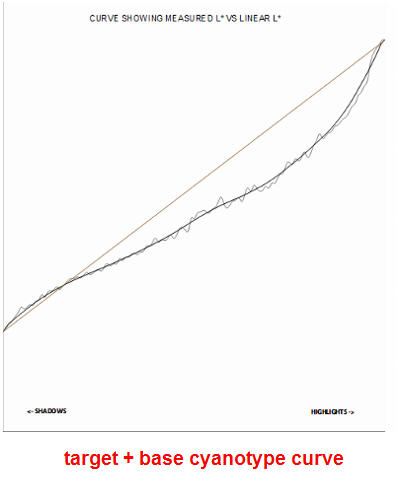

John, first you should know you are presenting good quality documentation which is so helpful. Walker is correct, you need at least one more iteration to create your personal customized curve. I was wondering if you had the Spyder Print tool, glad you invested in it.
If it were me and the next iterative .quad does the trick, I would go the extra step and create an ICC curve, too. That way you should have an easy solution to bring richer blues into those prints that need those deeper hues to produce a stronger aesthetic print. A technically accurate linear print is essential to controlling your process, but the aesthetic of the print itself is the true objective. A good ICC might save you from going all the way back to the digital file.
Best,
Don
OK, then I’ll do it! Unfortunately, by the time I get a linear curve I’ll need to mix up a new batch of Cyanotype, which will probably change everything.
I was planning create an ICC once the iterations converge. Since I’m on Windows, however, and cannot use Print-Tool, I will need to softproof in Photoshop “preserve numbers” checked. Since I customarily softproof in LR, I’m not sure how easy or useful this will be, but I’m eager to find out.
Any idea why the master printed so differently this time than the one you posted on 5/8? Same master.quad? Same darkroom procedure? Paper? etc?
In the earlier pair the midpoint looked good but hilites and lolites were too contrasty. The -lin resulted in it being too dark overall. This is almost the reverse.
In the first pair that you posted, the master was similar to this one, but the -lin didn’t change much.
I agree with Don and Walker to try one more -lin iteration.
One other thing to consider that I’ve written about somewhere, but maybe not in this thread. Because of the inherent variation in hand-coated processes, the best (but most tedious) practice is probably to make 3 (or more) prints of each target round and average the results, then use that average to make the linearization. Do the same thing with the linearized target to see if another iteration is necessary. I’ve only done this when the first print seemed off, and it did prove useful, but it’s a lot more time consuming, not to mention materials.
Attachment 1 has screenshots of all four Spyder measurement curves so we can talk about them without scrolling through posts scattered throughout this discussion.
As you can see, the old and the new base targets are not that different. The new base is darker than the old base possibly because I let it sit longer (allowing it to darken) before measuring it.
But as you can see, the linearized targets are wildly different. The old linearized target is WAY too dark and makes no sense when you look at the old base curve which it is trying to linearize. However the new linearized target looks like it is truly attempting to linearize the new base curve by lightening it.
So I have more confidence in the new linearization because it seems to be moving in the right direction!
Things were done the same except for the following:
(1) this time I allowed negatives to sit for at least 24h before printing them
(2) this time I moved my paper supply to a dry location
(3) this time I allowed paper to dry for 2 hours in a dry location after sensitizing
(4) this time I allowed prints to dry for at least 24h before measuring them.
I wonder if any of these differences could account for the problems in the first linearization. E.g., exposing paper that had not dried long enough.
The new final (lower right from the screenshot) linearized curve looks like you are on the right track for your darkroom conditions. Generally speaking that mid-tone bump up (lighter) in the measurements can be attributed simply to your wash time or an other number of small darkroom/procedure condition changes. As others have said in this thread, I suggest printing a few different targets (from the same neg) and processing them. Then measure all of these and average the measurements together. Most likely you will come up with a pretty linear result and if it isn’t linear you can always do a final final -lin.quad from these averaged targets. This final final -lin.quad is taking into account your general darkroom variability.
best regards,
Walker
all the best,
Walker
Great idea. I made a -lin-lin target negative yesterday. I will make three prints from today, then average the readings to get a -lin-lin-lin.quad.
I never realized Cyanotype was so sensitive to darkroom variables. I am using New Cyanotype; perhaps it is more sensitive.
Is there any use for the GCATS-out.txt file created by QTR-Linearize-Quad?
John, I am not certain there is much of a shelf life to potassium ferric cyanide. This compound is highly biodegradable, which is why it is one of the very first chemical compounds to be internationally regulated. FYI biodegradable speaks to a compound’s ability to return to its component parts.
The easy equation: it quickly becomes: potassium - mineral supplement, iron - needed by mammals and, oh yes, pure cyanide - toxic in trace amounts (parts per billion). Its use is banned worldwide from all restricted waterways and most riparian systems. OK, so the last part was political. The point for you is that once it is in solution it may not last all that long. Dry it will store a long time, but wet I would be suspect of any long inferred shelf life.
Don
Mike Ware claims a 1-year shelf life. I have been making 100 ml batches and using them up in three months on average (100 ml makes fifty 9 x 11 prints). As I go larger, I’ll be using it up faster. I’ll make my next batch 250 ml.
The change in color of the solution, as I get near the bottom of the bottle, concerns me, but I cannot say that there is any perceptible difference in the prints. Of course now that I am working on linearization, every small variable needs to be considered.
This is very interesting! I did another iteration. This time, I followed Walker’s suggestion and made three targets, measured them, and took average L-values into the Smoother. This was pretty much an academic exercise because I could see right away that the L-values values were actually DIVERGING FROM rather than converging to a straight line (see attachment 1). This is consistent with what I observed in my two previous attempts at linearization. We chalked it up to environmental factors, but I always suspected something else was going on (read on).
Here’s something Keith Schreiber said elsewhere: Classic Cyanotype (CC) has a short exposure scale whereas New Cyanotype (NC) has a much longer exposure scale.
Since I am using NC, and since the master cyanotype quad was undoubtedly made for CC, then I probably should have gone through the limiting process to create a custom master curve for NC. I had read about limiting in the Piezography Manual but didn’t think it applied to me. Now I think it does.
That steep dip in the highlights coming down from the top right is due to the Master being limited for a short scale process. There’s just not enough ink density there for a process that is approximately 2 stops longer in exposure scale. And my guess is that the flip-flops back and forth over the line are because it’s too much for the linearization process to handle.
Print the Limiter file using the Master quad, which will be closer to what you need than this one is. I expect it will print rather light and may even block up a bit in the highlights. The opposite of what this is doing. But that’s where you need to start to make a proper custom limited quad for the process. I did this, but for the 1430, and don’t think it can be easily translated for your printer.
